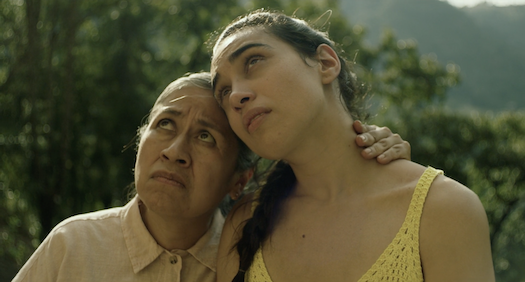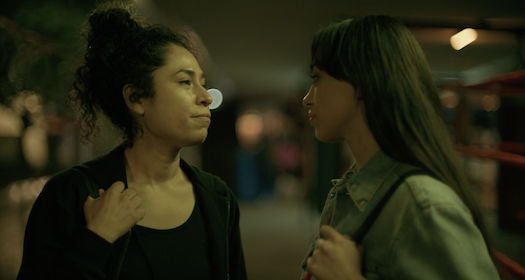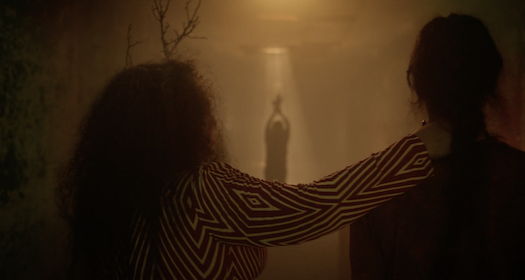Gotham Awards 2023: "Huesera: The Bone Woman" Stands Tall in a Stacked Category
 Wednesday, November 15, 2023 at 6:00PM
Wednesday, November 15, 2023 at 6:00PM by Nick Taylor

If awards-giving bodies serve one purpose, it’s to point curious, nubile cinephiles towards films they might not have otherwise come across. Unexpected, eccentric nominations are almost inherently fun to observe, especially from organizations meant to honor smaller films. Sure, the Gotham Awards removing their budgetary caps is a disappointing move, but aside from Barbie, several of their choices reflect what a great year this is for smaller, genuinely independent titles. And if we’re talking about titles, how could I not jump at the opportunity to check out a film called Huesera: The Bone Woman? Michelle Garza Cervera was recognized in the Breakthrough Director category, and for me, this is the ideal way of rewarding the strengths of this potent film.
Huesera follows Valeria (Natalia Solián), a woman living with her husband in Mexico City who has become pregnant for the first time. She seems genuinely smitten with her husband, who’s so affably nondescript I can’t remember if we actually learn his first name. Her relationship with her family is actively strained, facing antagonism from her mother and her married, nuclear-family-having older sister while the rest of the brood either tries to minimize their comments or let them happen. Only her “spinster” aunt, who mostly hangs out with other women and dresses in comparatively masculine fashions, has any time and empathy for Valeria.

Valeria’s pregnancy also coincides with the infrequent but terrifying appearances of a female humanoid with no face or voice, a ghoul whose movements are sharp and jerky and whose bones crack with every gesture. No one else can see this creature, though the psychological distress it causes Valeria and the increasing physical evidence that someone is attacking are very, very tangible. These encounters prompt Valeria to further enmesh herself in domestic and familial obligations, though she eventually begins wandering towards figures from a life she used to have that’s seemingly never been too far away, as well as the indigenous cultures her aunt travels in.
The script, which Cervera co-wrote with Abia Castillo, does not always find fresh structures on these dynamics. The spirit’s hauntings are notably repetitive as written. Valeria sees something fucked up, she reacts accordingly, another character (usually her husband) walks in to see her freaking out about nothing - or worse, see her surrounded by damage that only she could have reasonably caused. Yet Cervera stages these scenes so that each encounter with the spirit possesses its own sense of identity through its cinematography and sense of pacing, even as she maintains thru-lines of tone and sonic dread so Huesera remains a coherent cinematic experience. Cervera keeps finding new ways to visualize the creature’s menacing, almost taunting encroachments against Valeria, holding it at different distances from the camera and having it pop up from different parts of the frame. These scenes are even scarier for the way they keep us from completely seeing the spirit, making us look and squint to study it even as we squirm in discomfort. It’s as unpredictable in form and incident as it can possibly be within a repetitive structure.

Cervera’s keyed-up sound design is another major asset to both the hauntings and the domestic scenes. The uncomfortably loud cracking of bones, be it the creature’s jerky motions or Valeria’s anxious tic of cracking her knuckles or other body parts when she’s stressed, are a durably frightening marquee effect. There’s also great attention to atmospheric noise, the way the chatter of a crowded market can be punctuated by an odd sense of recognition with a stranger, or the way the stifled yet cheery air of a family gathering is overwhelmed by the empty silence of relatives allowing the black sheep to be utterly humiliated. They’re not novel sonic devices, but they’re used extraordinarily well to deepen and defamiliarize a story that might otherwise be too heavy-handed or too opaque with its allegories of maternal isolation and reverberating selves.
Huesera’s script deploys several threads of Valeria’s growing isolation and unhappiness, passions and interests she’s made to disregard for the security of her unborn child. Her apparent happiness chips away at a steady clip. Just over half an hour into the film, we’re shown Valeria’s life many years ago at a pivotal moment of decision-making, recontextualizing her increasing loss of self as the most recent effort in a long, fraught campaign to mold her life into something that might finally please her family. Soon after this, we get to spend a decent amount of time with an important figure from Valeria’s past, played by Prayers for the Stolen’s Mayra Batalla. I've leveraged a lot of this article as praising Cervera's direction in spite of her script, but the weaving of Valeria's selves without heavy-handed dichotomies of self or followinng a crudely emancipating trajectory is a strong, unique flavoring a lesser artist could have absolutely bungled. Same goes for the queer and indigenous elements revolving primarily (though not exclusively) around her aunt and the Batalla character, which also factors heavily into the climax.

Cervera depicts Valeria's past life and its conduits in the present with robust energy, unlike Huesera’s other tones up to this point. Yet these scenes, like so many elements of Huesera, feel disruptive of an internal order without reading as sloppy or out of place from a filmmaking standpoint. Cervera’s direction charges potentially stock interactions with enough history for the audience to really believe them, endowing the disparate corners of Valeria’s life with distinct textures. The Huesera we get ultimately isn't the very best version of this tale we could have gotten, but there's so much to appreciate on its terms, without any caveats or asterisks in admiration around "Good for a feature film debut." The heroically bittersweet ending only underlines how well Cervera has negotiated what freedom might mean, and might cost, for Valeria to really achieve, even amidst the guignol trappings.
Cervera is nominated alongside Georgia Oakley (Blue Jean), Raven Jackson (All Dirt Roads Taste of Salt), and Best Feature-double dippers A.V. Rockwell (A Thousand and One) and Celine Song (Past Lives). I’ve yet to see Jackson’s film, but measuring what’s ambitious, accomplished, and stilted amongst the other four films, I’d be just as happy seeing Cervera nabbing this prize as her more-hyped competition.

Huesera: The Bone Woman can be streamed with a subscription to AMC+, Amazon Prime, The Roku Channel, and YouTube, and is available to rent on most major platforms.



Reader Comments (2)
Honestly, I didn't love it as a whole even when I appreciate the screenplay. But if the film is not included in the Film Bitch Awards for best scenes of the year I'm gonna drive myself crazy.
If you already seen it, you know what scene I'm mean it.
The article provides me with a lot of valuable information. Helps me learn many things. Fireboy and watergirl is a game designed to help you relax and have fun.